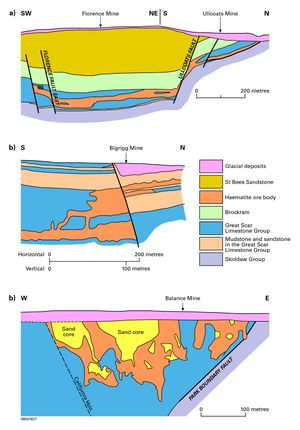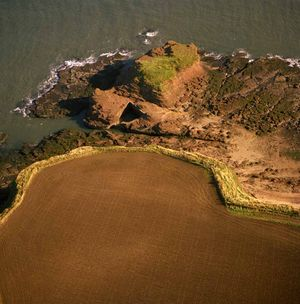Haematite deposits of Cumbria
| From: Stone, P, Millward, D, Young, B, Merritt, J W, Clarke, S M, McCormac, M and Lawrence, D J D. 2010. British regional geology: Northern England. Fifth edition. Keyworth, Nottingham: British Geological Survey. |
Introduction



The Carboniferous limestones of west and south Cumbria host a large number of haematite orebodies. The west Cumbrian iron orefield, which comprises a comparatively narrow belt of country extending between Lamplugh and Calder Bridge, may be considered in two unequal parts. Haematite was no doubt first discovered in the larger, exposed orefield north of Egremont (P916088) where Carboniferous limestone crops out at the surface. The southern, concealed portion of the orefield extends south of Egremont, where Carboniferous rocks pass beneath the unconformable cover of Permo-Triassic strata. Numerous mines have been worked in west Cumbria, the main centres of operation being Frizington, Cleator Moor and Egremont. The south Cumbrian orefield may also be viewed as two unequal parts. A small number of deposits were worked in the Millom area including, at Hodbarrow Mine (SD 178 785), some of the largest individual orebodies. A rather more extensive group of deposits lies in the area between Barrow, Dalton and Askham in the Furness peninsula. A single haematite deposit at Waterblean (SD 177 824), near Millom, occurs within Upper Ordovician, Dent Group limestone. It seems highly probable that haematite was worked for iron ore in Cumbria in pre-Roman times, though the first documentary records date from the 12th century. The 19th century witnessed the peak of production before large-scale mining ended in south Cumbria in 1968, and in west Cumbria in the late 1970s. Small-scale production for the manufacture of pigment continued until 2006 from shallow underground workings at Florence Mine, Egremont (NY 017 103). The Cumbrian haematite deposits typically occur as large irregular or flat-lying replacements of limestone, usually associated with or adjacent to faults (P916089) a and b. Original features of the host limestone, including bedding planes, stylolites, and fossils are commonly preserved in haematite, whereas mudstone interbeds may continue unreplaced through the ore. Haematite also locally replaces limestone-rich parts of the Brockram at the base of the west Cumbrian Permo-Triassic succession. True vein fillings of haematite occur locally both in the Carboniferous limestones, especially in the Furness area, and within the Lower Palaeozoic rocks of the Lake District, as described above. In addition to these orebody types, the Furness portion of the south Cumbrian orefield contains numerous haematite bodies known as ‘sops’. In these deposits, which are unique to Furness, haematite fills large, roughly conical dissolution hollows in limestone (P916089)c. The centre of each sop is typically filled with sand, probably derived from a previous cover of Permo-Triassic strata.
The Cumbrian deposits are composed almost exclusively of haematite but in a variety of forms. Compact, massive haematite is most abundant, but the area is famous for the fibrous mammillated variety known as ‘kidney ore’ (P220237), the distinctive conical broken fragments of which are termed ‘pencil ore’. Crystallised haematite, or ‘specularite’, is locally present in small quantities. Some manganese oxide minerals locally accompany the haematite and were worked on a small scale in a few mines in the Bigrigg and Askham areas. Other metallic minerals are generally very rare, though galena and copper sulphides have been recorded. Small amounts of chalcocite were raised from one mine at Anty Cross near Dalton-in-Furness, but it seems probable that the copper-bearing vein here predated the haematite orebody. Gangue minerals, which comprise only a very small proportion of the orebodies, include dolomite, calcite, aragonite, baryte and locally some siderite and fluorite.
The origin of the haematite deposits of the area has long attracted attention and controversy. Currently, the most widely accepted genetic models involve the transport of iron derived either from Permo-Triassic sedimentary rocks in the Irish Sea Basin, or from the granites of the western Lake District. Convective leaching of iron was effected by fluids circulating in response to a probable heat source beneath the Irish Sea. The iron-rich fluids were driven up-dip and gained access to the limestones via faults, and in the Furness area via dissolution hollows; large-scale metasomatic replacement of limestone then took place.
In west Cumbria the role of permeable Permo-Triassic rocks has been of crucial importance in determining the distribution of orebodies. Where these rocks rest directly upon Dinantian limestones, ore bodies are common, but where thick mudstones of Namurian, Westphalian or late Permian age intervene, orebodies are generally absent. The local abundance of specular haematite within the interstices of coarse-grained sandstones within the Coal Measures suggests that these too may have acted as mineralising aquifers in suitable structural settings. If so, hitherto undiscovered haematite orebodies could exist to the west of the known west Cumbrian orefield.
It is likely that a former covering of permeable Permo-Triassic or Carboniferous rocks acted as a pathway enabling mineralising fluids to gain access to fractures within the Lower Palaeozoic rocks of the Lake District, where haematite was deposited as fissure fillings. Such a hypothesis is entirely consistent with the comparative abundance of haematite veins in the western parts of the Lake District and their absence from the east of the region.
Fluid inclusion studies of gangue minerals suggest that the mineralising fluids were hypersaline brines at temperatures of up to 120°C. The age of this mineralisation is still a matter of dispute. Arguments have been advanced for a Permian or Early Triassic age, though other evidence favours a post-Triassic age.
Bibliography
Bouch, J E, Naden, J, Shepherd, T J, McKervey, J A, Young, B, Benham, A J, and Sloane, H J. 2006. Direct evidence of fluid mixing in the formation of stratabound Pb-Zn-Ba-F mineralisation in the Alston Block, North Pennine Orefield (England). Mineralium Deposita, Vol. 41, 821–835.
Cooper, M P, and Stanley, C J. 1990. Minerals of the English Lake District – Caldbeck Fells. (London: British Museum, Natural History.)
Crowley, S F, Bottrell, S H, McCarthy, M D B, Ward, J, and Young, B. 1997 δ34S of Lower Carboniferous anhydrite, Cumbria and its implications for barite mineralization in the northern Pennines. Journal of the Geological Society of London, Vol. 154, 597–600.
Fortey, N J, Ingham, J D, Skilton, B R H, Young, B, and Shepherd, T J. 1984. Antimony mineralisation at Wet Swine Gill, Caldbeck Fells, Cumbria. Proceedings of the Yorkshire Geological Society, Vol. 45, 59–65.
Ixer, R A, Stanley, C J, and Vaughan, D J. 1979. Cobalt-, nickel-, and iron-bearing sulpharsenides from the North of England. Mineralogical Magazine, Vol. 43, 389–395.
Ixer, R A, Young, B, and Stanley, C J. 1996. Bismuth-bearing assemblages from the Northern Pennine Orefield. Mineralogical Magazine, Vol. 60, 317–324.
Lowry, D, Boyce, A J, Pattrick, R A D, Fallick, A E, and Stanley, C J. 1991. A sulphur isotopic investigation of the potential sulphur sources for Palaeozoic-hosted vein mineralization in the English Lake District. Journal of the Geological Society of London, Vol. 148, 993–1004. 272
Millward, D, Beddoe-Stephens, B, and Young, B. 1999. Pre-Acadian copper mineralisation in the English Lake District. Geological Magazine, Vol. 136, 159–176.
Milodowski, A E, Gillespie, M R, Naden, J, Fortey, N J, Shepherd, T J, Pearce, J M, and Metcalfe, R. 1998. The petrology and paragenesis of fracture mineralization in the Sellafield area, west Cumbria. Proceedings of the Yorkshire Geological Society, Vol. 52, 215–241.
Shepherd, T J, and Goldring, D C. 1993. Cumbrian hematite deposits, northwest England. 419–443 in Mineralization in the British Isles. Patrick, R A D, and Polya, D (editors). (London: Chapman and Hall.)
Stanley, C J, and Vaughan, D J. 1982. Copper, lead, zinc and cobalt mineralization in the English Lake District: classification, conditions of formation and genesis. Journal of the Geological Society of London, Vol. 139, 569–579.
Vaughan, D J, and Ixer, R A. 1980. Studies of the sulphide mineralogy of north Pennine ores, and their contributions to genetic models. Transactions of the Institution of Mining and Metallurgy, Vol. 89, B99–100.
Young, B. 1985. The distribution of barytocalcite and alstonite in the Northern Pennine Orefield. Proceedings of the Yorkshire Geological Society, Vol. 45, 199–206.
Young, B. 1987. Glossary of the minerals of the Lake District and adjoining areas. (Newcastle upon Tyne: British Geological Survey.)
Young, B, Styles, M P, and Berridge, N G. 1985. Niccolite-magnetite mineralization from Upper Teesdale, North Pennines. Mineralogical Magazine, Vol. 49, 555–559.